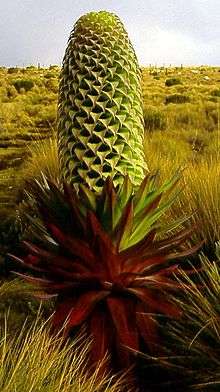Lobelia deckenii
| Lobelia deckenii | |
|---|---|
 | |
| Scientific classification | |
| Kingdom: | Plantae |
| (unranked): | Angiosperms |
| (unranked): | Eudicots |
| (unranked): | Asterids |
| Order: | Asterales |
| Family: | Campanulaceae |
| Subfamily: | Lobelioideae |
| Genus: | Lobelia |
| Species: | L. deckenii Hemsl., 1877 [1] |
| Binomial name | |
| Lobelia deckenii | |
Lobelia deckenii (syn. Lobelia keniensis) is a species of giant lobelia of the mountains of East Africa. It grows in moist areas, such as valley bottoms and moorland, in contrast to Lobelia telekii which grows in a similar, but drier habitat. These two species produce occasional hybrids. Lobelia deckenii plants usually produce multiple rosettes. Each rosette grows for several decades, produces a single large inflorescence and hundreds of thousands of seeds, then dies. Because individual plants have multiple rosettes, they survive to reproduce repeatedly, and plants with more rosettes flower more frequently. It is iteroparous.[2]
Lobelia deckenii plants usually consist of between one and eighteen rosettes, connected underground. Individual rosettes grow slowly in the alpine environment.[2] Individual rosettes may take decades to reach reproductive size, then die after flowering, but the connected rosettes live on.[2]
Lobelia deckenii is the only alpine species of lobelia that lives on Kilimanjaro,[3] commonly found between 3800 meters to 4300 meters.[4]
Lobelia deckenii ssp. keniensis is the variety of Lobelia deckenii that lives on Mount Kenya, between 3,300 and 4,600 m (10,800 and 15,100 ft). It is eaten less by rock hyrax than Lobelia telekii, which occurs more often in hyrax habitat. The lobelia species on Mount Kenya are both pollinated by birds,[5][6] especially the scarlet-tufted sunbird and the alpine chat.[7]
This species of giant lobelia is known for the reservoirs of water held in its rosettes, which freeze at night and protect the apical meristem held in a dense central leaf bud. When this reservoir is drained, the temperature of inner meristem drops below freezing, which does not occur when the fluid is left intact.[8] The crescent-shaped ice cubes formed in these rosettes give rise to the nickname, "gin and tonic lobelia".
References
- ↑ International Plant Names Index
- 1 2 3 Young, Truman P. (1984). "The comparative demography of semelparous Lobelia telekii and iteroparous Lobelia keniensis on Mount Kenya". Journal of Ecology. 72 (2): 637–650. doi:10.2307/2260073. JSTOR 2260073.
- ↑ Young, T.P. 1991. The flora, fauna, and ecology of Mount Kenya and Kilimanjaro. Pp. 37-49 In: Guide to Mount Kenya and Kilimanjaro (Iain Allan, ed.) Mountain Club of Kenya ISBN 978-9966-9856-0-6
- ↑ Kilimanjaro. O rei da África. Revista Planeta, dezembro de 2005.
- ↑ Young, Truman P. (1982). "Bird visitation, seed set, and germination rates in two species of Lobelia on Mount Kenya". Ecology. 68: 1983–1986. doi:10.2307/1940139.
- ↑ Burd, Martin (1995). "Pollinator behavioural responses to reward size in Lobelia deckenii: no escape from pollen limitation of seed set". Journal of Ecology. 83: 865–872. doi:10.2307/2261423.
- ↑ Smith, Alan P.; Truman P. Young (1987). "Tropical Alpine Plant Ecology". Annual Review of Ecology and Systematics. 18: 137–158. doi:10.1146/annurev.es.18.110187.001033.
- ↑ Young, Truman P.; Susan Van Orden Robe (1986). "Micro-environmental role of a secreted aqueous solution in afro-alpine Lobelia keniensis". Biotropica. 18 (3): 267–269. doi:10.2307/2388496. JSTOR 2388496.
External links
- Dressler, S.; Schmidt, M. & Zizka, G. (2014). [http://www.africanplants.senckenberg.de/root/index.php?submitForm=true&page_id=77&searchTextMenue=Lobelia+deckenii&filterRegionIDs[]=6&filterRegionIDs[]=1&filterRegionIDs[]=2&filterRegionIDs[]=3&filterRegionIDs[]=5 "Lobelia deckenii"]. African plants – a Photo Guide. Frankfurt/Main: Forschungsinstitut Senckenberg.